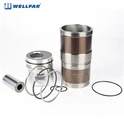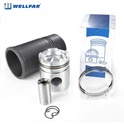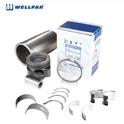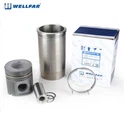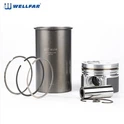Most of the piston pin bore is lubricated only by splash oil or centrifugal oil. As a result, piston pin bed are nearly always seizures due to lack of lubrication, with severely torn-up surfaces and fusion of materials.
On floating-fit piston pins, damage to the piston pin bores primarily arises:
►if the piston pin has insufficient clearance in the connecting rod bush.
►if the piston pin seizes or jams in the connecting rod bush.
This is indicated by piston pins with blue tempering colors around the connecting rod bush. If the freedom of movement of the piston pin is restricted in the connecting rod bush, the pin is forced to rotate in the piston pin boss. However, the clearance of a floating-fit piston pin in the piston pin bores is too small for this. Extreme build-up of heat, the collapse of the lubrication system and seizures due to lack of lubrication in the piston pin boss will occur as a result.

Due to the high temperature increase, the piston also expands a great deal more on the skirt in the area of the piston pin bores. There, this can lead to a lack of clearances as well as seizures due to lack of lubrication in the cylinder bore.
For piston pins that are shrunk into the connecting rod, the clearance in the piston pin bore is sufficiently dimensioned to ensure that an adequate oil film can form there. When reusing used shrink-fit connecting rods it is important to ensure that the bore in the connecting rod has not become distorted or damaged in any other way. Otherwise, once the piston pin has been shrunk in place it could become deformed to such an extent that the clearance in the piston pin bores is no longer sufficient, as a result of which slight seizure marks could form.



